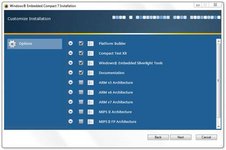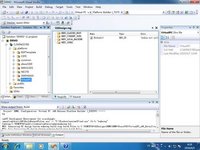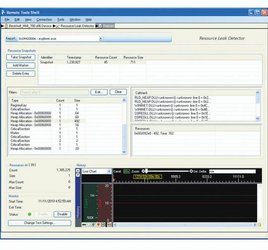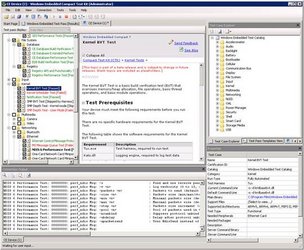Windows Embedded Compact 7
Windows® Embedded Compact 7 is the next generation product of Windows Embedded CE, the operating system for innovative and small-footprint devices. Designed specifically for embedded developers who need to bring new devices to market quickly and at the lowest possible cost. Windows Embedded Compact 7 provides a 32–bit native hard real-time, small footprint operating system with multi-core support (SMP), Silverlight support, Internet Explorer with Flash 10.1 and powerful embedded development tools.
Windows® Embedded Compact 7 interoperates with industry standards and existing Microsoft desktop and server technologies to help you create differentiated devices for a broad range of device categories, from commercial devices to consumer electronics products.
Find here an Overview Datasheet about Microsoft Windows® Embedded Compact 7.
Visit the secured download section for an Overview Presentation about Microsoft Windows® Embedded Compact 7 as well as for the Actual Windows CE and Compact Roadmap.
New in Windows Embedded Compact 7
What’s New in Windows Embedded Compact 7
Naming and Branding
- The name is now Windows Embedded Compact 7
Redesigned Architecture
- Support for multicore processors (SMP) up to 8 cores
- ARMv7 now supported
- CPU core management API provided
- Physical memory support up to 3 GB (512MB in CE 6.0)
- USB and SD storage much faster
- Bluethooth 2.1 plus EDR
- XML lite: Consistent with desktop implementation
- NDIS 6.1 supported
- IE 7 with Flash 10.1
New Licensing Structure
- 2 main licenses: C7E and C7P with no vertical restrictions
- 4 vertical restricted licenses: C7K, C7G, C7T and C7NR
- No more Core licenses
- No more Core-Plus licenses
Better Tools
- Platform builder designed as a plug-in for Microsoft Visual Studio® 2008. Use your existing development skills to build both an operating system and an application. A full Visual Studio 2008 Professional is now included in the Platform-Builder package with no price increase!
- Updated catalogue functionality
- Updated compilers
- New integrated silverlight development tools
Better Support
- Ten-year extended support
- Worldwide partner base and community collaboration
- Free evaluation kit to evaluate and test your system for 180 days
Faster Development
- End-to-end development portfolio to help you easily configure, build, and ship new devices
- Integrated development emulator eliminates having to use multiple tools from various sources
- Several hundred test components ready to use
- More source code access to help you debug, test, and make changes to an operating system image
Enabling New Business Opportunities
- The Cellcore Stack component helps devices establish data and voice connections over cellular networks
- The Windows Media Connect and Digital Video Recording components help devices consume media from Windows 7-based PCs and record, pause, and rewind live video streams
- The Windows Network Projector component will make it easier for meeting attendees to give a presentation from a Windows Vista based PC
New Windows Embedded Compact 7 System Architecture
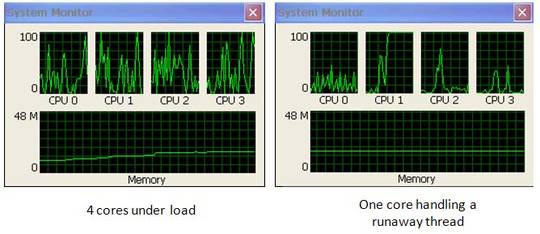
- Support for physical memory up to 3 GB
- Multicore support (SMP) up to 8 cores
Development Tools and Process
Platform Development Tools
Platform Builder for Windows Embedded Compact 7 (a plug-in for Visual Studio 2008) is an integrated development environment (IDE) for building customized embedded operating system designs. Platform Builder comes with all of the development tools needed to design, create, build, test, and debug your project.
Process Platform Development Tools
The integrated ARM based Emulator helps you easily test your CE image without having a hardware platform.
Application Development Tools
To write applications for Windows Embedded Compact 7, Microsoft offers a familiar set of programming languages that use managed or unmanaged code. Visual Studio 2008 takes full advantage of the .NET Compact Framework, which uses public Internet standards to enable integration with new and existing applications running on any platform. Supported languages include Visual C++, Visual C#, and Visual Basic. Siliverlight technology is fully integrated as well.
Windows Embedded Compact 7 Development Process
We can divide between the device OS development and the application development. To start with the device development, you need a BSP (Board Support Package) from a board manufacturer or start with a built in standard BSP. All needed drivers, configurations and settings are stored in the BSP. The more complete a BSP is, the less work you have to do! You can test your image via the device emulator. Don't forget to choose the emulator BSP as well in your project. After you have finished the OS design, you can export a SDK (Software Developmet Kit). The SDK contains the API-Set (Programmer Interface) supported through your Windows Embedded Compact 7 Image. An application developer can now install this SDK to write applications for your Windows Embedded Compact 7 Image and test it as well on the emulator first. There are different debugging tools and a Windows Embedded Compact Test Kit available in the Platform Builder Toolchain.
Windows Embedded Compact 7 Key Features
Key Facts | Description |
|---|---|
Real-Time | Windows Embedded Compact 7 is the only operating system from Microsoft with native real-time capabilities. Of course, the latency times vary with the speed and architecture of the processor. |
Low Cost | Low upfront capital investment through free evaluation tools, low cost development tools and lowest cost licensing to reduce total cost of development. |
Processor Architectures | The following four 32-bit CPU architectures are supported: x86, ARM, MIPS32 and SH4. New in Compact 7 is the support for ARMv7. |
Modular | More than 500 components to select. There are 2 different licenses with different component sets without vertical restrictions: C7E (Embedded)and C7P (Professional). 4 vertical restrictel licenses are available for: Portable Navigation Devices (C7NR), Network Projectors (C7K), Consumer Internet Media Devices (C7G) and Thin Clients (C7T). |
Shared Source | Get with the Shared Source Program over 4 million source code lines. Use the shared source code to document, debug, test, and modify the OS image to create differentiated features. You are allowed to use and change this source code. |
Small Footprint | The kernel use around 700kB of the footprint. Normal industrial WEC7 devices use around 4-6 MB, a full featured Mobile build around 20 MB. The application is not included. |
Mobile Devices | Special functionality for mobile devices is included. I.e. power management, instant-on and small footprint for flash usage. Of course, all new communication stacks and media capabilities are included in Windows Embedded Compact 7. |
Time-To-Market | Windows Embedded Compact 7 provides embedded developers with a unified set of tools to build, debug, and deploy customized Windows CE-based devices. This fully integrated development environment (IDE) also includes emulation technology to enable simultaneous hardware and software development. Platform-Builder designed as a plug-in for Microsoft Visual Studio 2008. Use your existing development skills to build both an operating system and an application. |
Industry Standard | Windows Embedded Compact 7 interoperates with industry standards and existing Microsoft desktop and server technologies to help you create differentiated devices for a broad range of device categories, from commercial devices to consumer electronics products. Microsoft committed to a ten-year extended support for Windows Embedded Compact 7. |
Application Development | To write applications for WEC7, Microsoft offers a familiar set of programming languages that use managed or unmanaged code. Visual Studio 2008 now takes full advantage of the .NET Compact Framework, which uses public Internet standards to enable integration with new and existing applications running on any platform as well as native code development. Supported languages include Visual C++, C#, and Visual Basic. Silverlight technology is now fully implemented into Windows Embedded Compact 7. |
